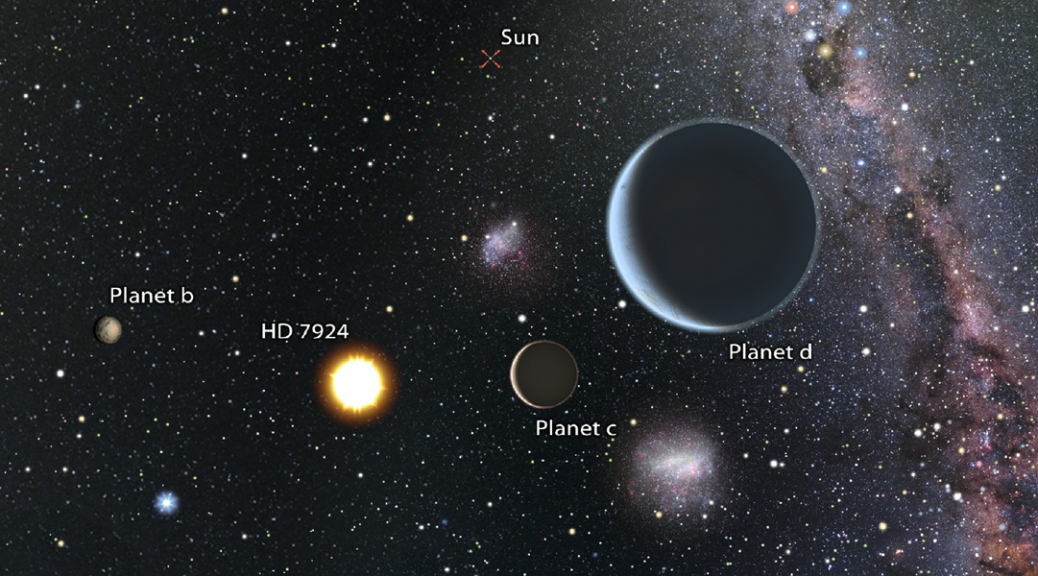NASHVILLE, Tenn. (TSU News Service) – A team of astronomers using ground-based telescopes in Arizona, California, and Hawaii recently discovered a planetary system orbiting a nearby star that is only 54 light-years away from our solar system. All three of its planets orbit their star at a distance closer than Mercury orbits the Sun, completing their orbits in just 5, 15, and 24 days.
The astronomers, from Tennessee State University, the University of Hawaii at Manoa, the University of California, Berkeley, and the University of California Observatory found the planets using measurements from the Automated Planet Finder (APF) Telescope at Lick Observatory in California, the W. M. Keck Observatory on Mauna Kea, Hawaii, and the TSU APFs at Fairborn Observatory in the Patagonia Mountains of southern Arizona.

The team discovered the new planets by detecting the wobble of the star HD 7924 as the planets orbited and pulled on the star gravitationally. The APF and Keck Observatory traced out the planets’ orbits over many years using the Doppler technique that has successfully found hundreds of mostly larger planets orbiting nearby stars. In coordination with the APF and Keck Observations, the TSU APF made crucial brightness measurements of HD 7924 over nine years to assure the validity of the planet discoveries.
TSU has also been developing and operating robotic telescopes for over 20 years.
“The robotic telescopes are a wonderful advancement,” said TSU astronomer, Dr. Gregory Henry, who oversees the operation of seven robotic telescopes for his research. “They take away the tedium of all-night, manual observing sessions and produce far more superior data.”
One of the TSU robotic telescopes discovered the first transiting extrasolar planet in 1999, providing final proof of the existence of other planetary systems.
The Keck Observatory found the first evidence of planets orbiting HD 7924, discovering the innermost planet in 2009 using the HIRES instrument installed on the 10-meter Keck I telescope. This same combination was also used to find other super-Earths orbiting nearby stars in planet searches led by UH astronomer Andrew Howard and UC Berkeley Professor Geoffrey Marcy. It took five years of additional observations at Keck, a year-and-a-half campaign by the APF Telescope, and nine years of APT monitoring to find the two additional planets orbiting HD 7924.
According to Henry, the Kepler Space Telescope has discovered thousands of extrasolar planets and demonstrated that they are common in our Milky Way galaxy. However, nearly all of these planets are far from our solar system, he said.
“Most nearby stars have not been thoroughly searched for the small ‘super-Earth’ planets (larger than Earth but smaller than Neptune) that Kepler found in great abundance,” Henry added.
This discovery shows the type of planetary system that astronomers expect to find around many nearby stars in the coming years.
“The three planets are unlike anything in our solar system, with masses 7-8 times the mass of Earth and orbits that take them very close to their host star,” said UC Berkeley graduate student Lauren Weiss.
Henry added that TSU automated telescopes will also make an important contribution to automated planet discovery.
“The APF measurements of the planetary host star’s brightness will allow us to determine whether star spots are mimicking the presence of a false planet,” said Henry.
The robotic observations of HD 7924 are the start of a systematic survey for super-Earth planets orbiting nearby stars. University of Hawaii graduate student B. J. Fulton will lead this two-year search with the APF as part of his research for his doctoral dissertation. Henry will measure any brightness changes in the same stars with the TSU APTs.
“When the survey is complete, we will have a census of small planets orbiting Sun-like stars within approximately 100 light-years of Earth,” says Fulton.
The paper, “Three super-Earths orbiting HD 7924,” has been accepted for publication in the Astrophysical Journal. Other authors of the paper are Howard Isaacson (UC Berkeley), Evan Sinukoff (UH), and Bradford Holden and Robert Kibrick (UCO). The team acknowledges support of the Gloria and Ken Levy Foundation, NASA, NSF, the U.S. Naval Observatory, the University of California for its support of Lick Observatory and the State of Tennessee through its Centers of Excellence program.
Tennessee State University
3500 John Merritt Boulevard
Nashville, Tennessee 37209
615.963.5331
About Tennessee State University
With more than 9,000 students, Tennessee State University is Nashville’s only public university, and is a comprehensive, urban, co-educational, land-grant university offering 45 undergraduate, 24 graduate and seven doctoral programs. TSU has earned a top 20 ranking for Historically Black Colleges and Universities according to U.S. News and World Report, and rated as one of the top universities in the country by Washington Monthly for social mobility, research and community service. Founded in 1912, Tennessee State University celebrated 100 years in Nashville during 2012. Visit the University online at tnstate.edu.
